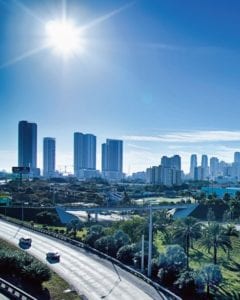|
Getting your Trinity Audio player ready...
|

It seems that buses, bus rapid transit, trolley, and rails are all the jive on the street. And everyone from policy makers to casual observers has an opinion, a plan, or a dream, about regional transportation – and where we go next.
In Miami-Dade County, just 3 percent of the traveling public uses public transit. They probably live close to a Metrorail Station or can easily drive to one to hop a train. There are also those who have no choice but to travel by bus. That leaves 97 percent driving cars to get around locally.
So, “Is that all there is?” In the immortal words of American singer Peggy Lee, the answer is no. Because even in the end of her hit 60s song by the same name, she changes her way of thinking with an upbeat message of hope, alternatives, and optimism.
Give in? “Oh no, not me,” she says.
Reliable notes on this matter can be found in research published by Robert Poole, a transportation specialist with The Reason Foundation, a Los Angeles-based think tank. In fact, an article entitled, “Developing Transit Service for the 21st Century,” states that “transit agencies must change the way they think and plan to offer cost-effective mobility transit options.” It outlines the challenges facing the Miami-Dade our area and looks at ways other cities are endeavoring to improve transit service and ridership.
Interestingly enough, Miami-Dade County Mayor Carlos Gimenez is also at the forefront of this new thinking.
And furthermore, as one might expect, technology is front and center when it comes to addressing local transit challenges.
Miami-Dade County is fairly well covered by local bus service and more recently by municipal trolley services – which, by the way, are little buses disguised to look like trolley trains.
However, the county lacks a true bus express rapid-transit service which would offer the possibility of increasing bus speeds – just what potential riders are looking for.
This is a much more flexible mobility option because it can be implemented much faster than a network of commuter trains, while mimicking the level of service of a train at a fraction of the cost. It also would allow for a “building” of ridership along corridors. The local existing expressway infrastructure in Miami-Dade County offers an opportunity for bus express rapid transit service.
This is where the Transportation Planning Organization stepped in, by asking MDX to take over the east-west movement within the SR 836/Dolphin Expressway. MDX is aiming at innovating and implementing the first urban-express service in the county using XT (Xpress Technology) lanes. Right now, these new lanes are being constructed on the wider and reinforced inner shoulders of the Dolphin.
Recognizing many people don’t think highly of bus service, MDX is working to change that perception, by deploying top-notch executive charter type vehicles that will entice their own commuters to travel by way of this premium transit option over their own vehicle.
While details and operational guidelines are still being worked out, MDX plans to procure private entities to operate the urban-express service while establishing the parameters and funding for a pilot program to start within a timeframe of a year.
According to transportation planners, given Miami-Dade’s urban configuration and growth trends, it seems prudent to implement transit service incrementally – driven by demand and funding availability. Service should be gradually rolled out and include local buses, express buses, and then trains wherever appropriate.
Another interesting prospect is the use of MDX XT lanes along the Dolphin Expressway to offer a future mobility option using public and private autonomous vehicles – for “platooning,” which can carry even more units than a train.
We will get there, because it seems we may finally be on the right course. Ultimately, what we can all hope for is an integrated system offering multiple modes of transportation or mobility options for travelers to pick from based on what best fits their needs. That decision is a personal one made easier through a new upbeat way of thinking by government that offers smart options, alternatives, and vision.







Comments are closed.